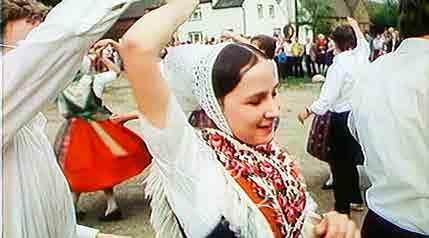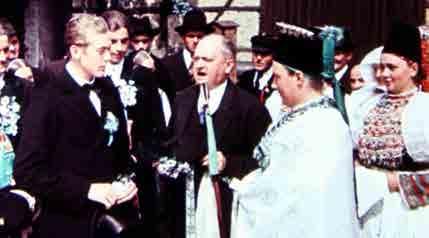
8 minute read
Hommage: Der letzte Braschka im Revier Helmut Kurjo / The Region‘s Last Braschka Helmut Kurjo
Der letzte Braschka im Revier. Helmut Kurjo
Jährlich widmet das FilmFestival Cottbus einer/einem Lausitzer Film- oder Kunstschaffenden eine Hommage. Erstmals richten wir in diesem Jahr den Blick auf einen Vertreter sorbischer Volkskunst. Der 1935 geborene Helmut Kurjo übernahm 1969 das Amt des Pobraschkas (Hochzeitsbitter) und hat unzählige sorbische Hochzeiten und Trachtenzüge nach alter Tradition ausgestattet und begleitet. In einer wendischen Familie aufgewachsen, hatte er erst in der Schule Deutsch gelernt. Neben seiner Arbeit als Futtermeister in einer Milchviehanlage engagierte er sich leidenschaftlich im dörflichen und religiösen Leben, das anfangs noch ein sorbisches war. Die Hochzeitszeremonien erlernte er von seinem Vorgänger, dem Braschka Wuschko, und trug im Laufe der Jahre Schritt für Schritt eine beeindruckende Sammlung historischer sorbischer Trachten und Schmuckstücke, Tücher, Spitzen, Fotos, bemalter Ostereier, Möbelstücke, Werkzeuge, Spinnräder, Hausrats, Dokumente und vieles mehr zusammen. Er kennt noch die alten Lieder und war den Hörerinnen und Hörern des sorbischen Rundfunks auch als Laienprediger ein Begriff. In der Mittellausitzer Region zwischen Schwarze Pumpe und Hoyerswerda, zu der neben Bluno noch die Dörfer Proschim, Sabrodt und Terpe gehören, ist er heute der letzte Muttersprachler.
Advertisement
Und hier liegt die Tragik, die sich in den drei Filmen eindrücklich vermittelt: Während sich 1956 noch ein reiches sorbisch-dörfliches Leben vor der Kamera abspielt, ist dieses 1987 nur noch in Resten vorhanden und findet der Regisseur Peter Rocha zehn Jahre später lediglich Relikte und Erinnerungen vor. Wie in einem Brennspiegel dokumentiert das Programm, welches ursprünglich als Porträt eines engagierten Volkskünstlers angelegt war, nun auf schmerzhafte Weise das Verschwinden einer Kultur im Verlauf eines Menschenlebens. Indizien für die Ursachen finden sich ebenfalls in allen drei Filmen: Beginnend mit den Schornsteinen von Schwarze Pumpe als Symbole einer damals enthusiastisch begrüßten Industrialisierung, über den Kohlezug 1987, bis hin zu endlos klaffenden Löchern 1997 neben einem Dorf, aus dem mit dem Wegzug der Jungen das Leben zu weichen scheint.
Dass es sich heute, zwei Jahrzehnte später, wieder regt und sorbisch-wendisches Selbstbewusstsein eine Renaissance erlebt, ist Menschen wie Helmut Kurjo zu verdanken. In der Ethnologie nennt man sie „bearer of traditions“ – jene, die die Tradition in sich und weitertragen. GL
The Region’s Last Braschka. Helmut Kurjo
Every year the FilmFestival Cottbus pays homage to a Lusatian artist/filmmaker. This year, for the first time, we turn our attentions to a representative of Sorbian folk art. Helmut Kurjo, born in 1935, took over the post of Pobrashka (master of ceremonies) in 1969 and has, since then, accompanied numerous Sorbian weddings and supplied costumes, all in accordance with the old tradition. Having grown up in a Wendish family he only started to learn German at school. In addition to his work on a dairy farm he was passionately involved in village and religious life that was, back then, still very much Sorbian. He learned the wedding ceremonies from his predecessor, Braschka Wuschko, and over the years came to accumulate an impressive collection of historical Sorbian costumes and jewellery, scarves, lace, photographs, painted Easter eggs, furniture, tools, spinning wheels, household items, documents and much more. He still knows the old songs and made a name for himself as a lay preacher amongst listeners of Sorbian radio. In the central Lusatian region between Schwarze Pumpe and Hoyerswerda, which besides Bluno numbers the villages of Proschim, Partwitz and Terpe, he is today the last native speaker.
And herein lies the tragedy which is impressively conveyed in these three films: while in 1956 a vibrant Sorbian-village life plays out in front of the camera, by 1987 only remnants remain thereof and ten years later director Peter Rocha finds nothing but relics and memories. In a manner akin to a concave mirror this programme, initially intended as a portrait of a dedicated folk artist, painfully documents the disappearance of a culture in the course of a lifetime. Reasons for the causes thereof can be found in all three films: starting with the chimneys of Schwarze Pumpe as symbols of a then enthusiastically welcomed industrialisation, on a coal train in 1987 and ending in 1997with the endless gaping pits alongside a village almost devoid of life since the young generations leave.
It is thanks to people like Helmut Kurjo that today, two decades later, Sorbian-Wendish self-assertiveness is once again experiencing a renaissance. In ethnology such individuals are referred to as bearers of tradition, that is to say those who carry tradition both within themselves and onto future generations. GL
POBRASCHKA – DER HOCHZEITSBITTER POBRASCHKA – DER HOCHZEITSBITTER POBRASCHKA – THE MASTER OF CEREMONIES
MICHAEL BÖRNER / DDR / GDR, 1987, 19 MIN
Der Hochzeitsbitter Helmut Kurjo aus Bluno bei der Ausrichtung der – vielleicht letzten – sorbischen Hochzeit der Region, im Alltag zwischen LPG und reger Brauchtumspflege. Zugleich ist der Film das Porträt einer Kultur am Rande ihres Verschwindens. The master of ceremonies Helmut Kurjo, a native of Bluno, as he organises what might be the region‘s last Sorbian wedding and deals with everyday business that ranges from the collectivised farms to the active preservation of tradition. At the same time the portrait of a culture on the verge of extinction.
Michael Börner
Filme EINE SORBISCHE FOLKLOREGRUPPE - SPRJEWJAN. SERBSKA FOLKLORNA SKUPINA (1987, short, doc, FFC 2016)
Es ist 1987, die alten Frauen gehen noch in Tracht und treffen sich zum Federschleißen. Kurjo, der das Amt des Braschka seit 1969 ausführt, redet in der Familie noch Sorbisch, aber auf der Hochzeit wird Deutsch gesprochen. An Stelle der kaum noch stattfindenden „echten“ treten zunehmend „geführte Trachtenhochzeiten“. Kurjo ist auf der Suche nach einem Nachfolger und erzählt mit „Stolz und Traurigkeit“ von Vergangenheit und Gegenwart des Sorbischen – während am Rand des Dorfes ein Kohlezug durch das Bild fährt. GL
It‘s the year 1987: the old women are dressed in costume and meet for the stripping of the feathers. Kurjo, who has served as Braschka since 1969, still speaks Sorbian at home but at the wedding it is German that dominates. In place of the “real” thing one increasingly observes “staged” traditional weddings. Kurjo is looking for a successor and speaks with “pride and sadness“ of the past and present of Sorbian traditions: all the while, on the outskirts of the village, a coal train passes by. GL
KURJOS HOF KURJOS HOF KURJOS YARD
PETER ROCHA / DEUTSCHLAND / GERMANY, 1997, 30 MIN
Hier wohnt die Familie Kurjo, in der einst alle Wendisch sprachen, die jüngste Generation aber nur noch auf Deutsch antwortet. Ihr Hof ist ein Refugium sorbischen Lebens inmitten klaffender Tagebau-Löcher. Poetisch-melancholischer Abgesang. Here live the Kurjo family: though they once all spoke Wendish, today the youngest generation is only able to respond in German. The family farm is a refuge of Sorbian life in the midst of gaping open pit holes. A both poetic and melancholic farewell.
Peter Rocha Filme HOCHWALDMÄRCHEN (1988, short, FFC 2014) WITAJ HEIßT: ICH GRÜßE DICH (1980, short, doc, FFC 2016) DIE SCHMERZEN DER LAUSITZ (1989/90, doc, FFC 2017) Heimat/Domownja/Domizna HOMMAGE
Der Film folgt Schritt für Schritt dem Anlegen einer Tracht. Er begibt er sich anhand der Erzählungen Helmut Kurjos, von Alltagsbeobachtungen und inszenierten Szenen, alten Fotos und sorbischen Liedern in eine Welt, die zum Zeitpunkt der Dreharbeiten schon fast nur noch Erinnerung ist und teilweise wie ein Traum erscheint. DEFA-Regisseur Peter Rocha, Chronist der „Schmerzen der Lausitz“ (DIE SCHMERZEN DER LAUSITZ, FFC 2006, 2017), kontrastiert das verschwundene dörfliche Leben mit erschreckenden Bildern der aufgerissenen Erde im Revier um Schwarze Pumpe – dort, wo einst Kurjos Felder waren. GL The film follows the steps involved in the donning of a traditional costume. Based on Helmut Kurjo‘s narrations everyday observations, staged scenes, photos of a bygone age and Sorbian songs, it transports us to a world that, at the time of filming, is almost but a mere memory and at times strikes the viewer as a dream. DEFA director Peter Rocha, chronicler of the “pain of Lusatia” (THE PAIN OF LUSATIA, FFC 2006, 2017), contrasts a near-extinct rural life with alarming images of the scarred landscape in the area around Schwarze Pumpe: the area that was once home to Kurjo‘s fields. GL
Filmformat / Format mp4 | s/w / b/w Darsteller / Cast Helmut Kurjo Produktion / Production Rocha-Film
WENN JAN UND LENKA HOCHZEIT MACHEN WENN JAN UND LENKA HOCHZEIT MACHEN THE MARRIAGE OF JAN AND LENKA
HANS-GÜNTER KADEN / DDR / GDR, 1956, 18 MIN
Eine sorbische Hochzeit in Sabrodt, vor der Kulisse der Schornsteine des (damals gerade errichteten) Gaskombinats Schwarze Pumpe – und „ein Braunkohlekumpel ist als Schwiegersohn nicht unwillkommen“. A Sorbian wedding in Sabrodt against the backdrop of the chimneys of the (then recently constructed) Schwarze Pumpe power station and the remark „a fellow miner is not unwelcome as a son-in-law“.
Hans-Günter Kaden
Der Braschka (Hochzeitsbitter) begleitet das Paar und die in Tracht erschienene Dorfgemeinschaft von der vorherigen Einladung und dem Anlegen der Brauttracht am Morgen bis zum Abnehmen des Brautschmucks in der Nacht. Der frühe DEFA-Film hat nicht nur Hochzeitsbräuche der Region im Detail aufgezeichnet, sondern ist heute vor allem beeindruckender Beleg eines damals komplett sorbischen Lebens in den „Heidedörfern um Hoyerswerda“, das sich beiläufig und manchmal am Rand der Inszenierung vor der Kamera entfaltet. Somit ist der Film auch das Dokument eines Verlustes. GL

The Braschka (or master of ceremonies) accompanies the couple and the village community, the latter also in traditional costume, from the invitation process and the donning of the wedding dress in the morning to the removal of the bridal jewellery in the evening. This early DEFA film not only captured the region‘s wedding customs down to the last detail but also today provides, above all, impressive evidence of what was then an exclusively Sorbian existence in the „Hoyerswerda Heathlands“, a life which is revealed in an incidental, at times almost marginal, fashion. As such, the film today also speaks of the loss the region has undergone. GL
Filmformat / Format DVD | doc. | Farbe / Colour Drehbuch / Script Mercin Nowak-Njechornski Kamera / Photography Ewald Sudrom Schnitt / Editing Evelyn Carow Musik / Music Jurij Winar Produzent / Producer Heinz Rüsch Produktion / Production DEFA-Studio für populärwissenschaftliche Filme Kontakt / Contact Deutsche Kinemathek - Museum für Film und Fernsehen DEFA-Filmverleih Mirko Wiermann Potsdamer Str. 2 10785 Berlin Germany +49 30 30 09 03 63 4 www.deutsche-kinemathek.de defa-filmverleih@deutsche-kinemathek.de








